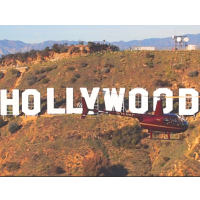FAA Wants No Part of Regulating Annoying Helicopters Hovering over Los Angeles

The Federal Aviation Administration (FAA) blew off complaints from members of the California congressional delegation and recommended last week that Los Angeles residents who are bothered by the swarms of helicopters that fly and hover over the city should work out their grievances privately with local authorities and chopper operators.
The FAA won’t help them by regulating the omnipresent helicopters that criss-cross the city monitoring traffic, gawking at landmarks like the Hollywood Bowl, covering news events for local media, ferrying wealthy patrons around the basin and otherwise making a nuisance of themselves.
The federal agency gave a lot of reasons for not wanting to write new regulations to govern Los Angeles air space and spent a good deal of time in its report on the situation laying out the complex variables—topography, weather, high-volume air traffic, competing economic interests, multiple government stakeholders—that would limit its effectiveness.
The sky is crowded. Los Angeles County has 27 different airports and 138 heliports registered with the FAA. There are also “numerous” unregistered heliports, according to the agency. The report acknowledges that the city has struggled with helicopter fly-bys for at least two decades without success.
The FAA did not totally wash its hands of the helicopter mess. Although it said that a solution “must be developed through local engagement and collaboration with community associations, the flying community and local government,” it did list 10 specific areas and activities, like “plane spotting,” that would benefit from some new flight rules.
Plane spotting is a hobby, growing in popularity, that attracts people who are fascinated by the comings and goings of flights. At least one helicopter company takes customers into the sky above Los Angeles International Airport (LAX) to photograph aircraft and otherwise indulge their aerial attraction.
The FAA left it to others to apply its suggestions for controlling the helicopter problem, which included: limiting hovering, restricting chopper flights, charging fees for helicopter operations, keeping the copters at higher altitudes, establishing helicopter routes and reducing news gathering operations in the sky.
Democratic Congressman Adam Schiff was not happy with the FAA’s decision to punt the issue to local negotiators, but didn’t seem surprised in his official statement.
“The report recommends several steps to minimize helicopter noise, but, not surprisingly, stops short of recommending regulatory action opposed by industry,” he wrote. “Voluntary measures in the past have provided little relief for residents, and I am skeptical that without a determined effort to oversee them by the FAA that they will do so now.”
–Ken Broder
To Learn More:
FAA Says Regulation Not the Answer to L.A. Helicopter Noise Problems (by Dan Weikel, Los Angeles Times)
FAA Rejects Regulatory Approach to Helicopter Noise (by Nick Green, San Gabriel Valley Tribune)
FAA Offers Suggestions to Reduce L.A.'s Helicopter Noise, but No New Regulations (by Rina Palta, KPCC)
Report on the Los Angeles Helicopter Noise Initiative (Federal Aviation Administration)
- Top Stories
- Controversies
- Where is the Money Going?
- California and the Nation
- Appointments and Resignations
- Unusual News
- Latest News
- California Forbids U.S. Immigration Agents from Pretending to be Police
- California Lawmakers Urged to Strip “Self-Dealing” Tax Board of Its Duties
- Big Oil’s Grip on California
- Santa Cruz Police See Homeland Security Betrayal in Use of Gang Roundup as Cover for Immigration Raid
- Oil Companies Face Deadline to Stop Polluting California Groundwater





